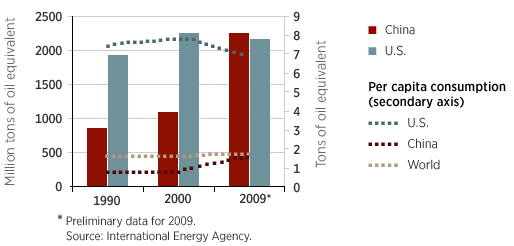The International Energy Agency estimates that China has just surpassed the United States in overall energy consumption. What opportunities does this present for investors?
Robust growth in China’s energy consumption
Consumption of energy in China has doubled over the past decade, and the International Energy Agency (IEA) estimates that the country has just surpassed the United States in overall energy consumption. This robust growth has been a key driver in global demand for energy. China accounts for about half of estimated global demand growth in 2010.

Will the rapid growth continue?
The outlook for 2011 is a bit more tempered. The IEA expects China will account for about one third of 2011 global demand growth as China’s government gradually reduces fiscal and monetary stimulus programs. However, China should remain a critical factor in the global supply/demand balance for energy, as per-capita consumption — which is currently only about one third of the Organization for Economic Co-operation and Development average — rises toward global levels. Given that China is a net importer of oil and natural gas, there are several bullish implications for investors.
Growing demand brings opportunities for investors
Chinese demand growth represents a tightening factor, over time, in the global balance of supply and demand for energy, especially crude oil and natural gas. As the world recovers from the economic slowdown, this should support a positive longer-term trajectory for commodity prices, especially for oil, where we see structural constraints to supply growth. We see attractive opportunities to invest in exploration and production, and in integrated oil companies that we believe are well positioned to grow oil production and reserves for many years to come.
Investors may also benefit from M&A activity
To meet the country’s growing demand for hydrocarbons, companies domiciled in China are looking to broaden their asset bases through international acquisitions. Recently, we have seen Chinese companies acquire assets in areas ranging from the Canadian oil sands to the Ugandan countryside. Continued merger and acquisition activity from Chinese and other major international players should support the valuations of exploration and production companies with acreage in high-potential exploration frontiers — such as Ghana, Uganda, and Greenland — as well as in low-risk “exploitation” regions such as the Marcellus Shale and Haynesville Shale in the United States.
Another growth area: liquefied natural gas
Chinese natural gas consumption should see robust growth following investments in the power sector and initiatives to reduce emissions. Emissions today in China are high, given the country’s reliance on coal. As a result, we expect liquefied natural gas (LNG) imports will grow materially over time. We see attractive opportunities to own the suppliers of LNG, much of which will be sold on long-term contracts with prices expected to be linked to crude oil. There are several LNG projects on the development slate in Australia, and we have been looking closely to identify the winners there.
Opportunities in “green” energy
Over time, we believe the share of demand allocated to alternative forms of energy, such as wind and solar, will grow substantially off its current small base. The pace of that growth will hinge on what forms of legislation are passed in key consuming nations on matters such as greenhouse gas emissions, energy efficiency, and specific promotion of the use of renewable energy. Over the long term, we are likely to see multiple opportunities for investors to gain exposure to green energy. However, without legislation that effectively promotes the use of alternatives, these options are generally longer dated than our investment horizon. That said, we continue to work with analysts from our technology and industrials teams to monitor developments in alternative energy, particularly in the solar sector.
More in: Global sector, International



